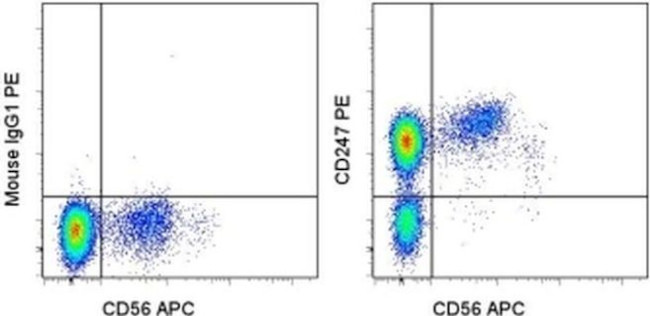Search Thermo Fisher Scientific
Invitrogen
CD247 (CD3 zeta) Monoclonal Antibody (6B10.2), PE, eBioscience™
图: 1 / 1
CD247 (CD3 zeta) Antibody (12-2479-82) in Flow

产品信息
12-2479-82
种属反应
已发表种属
宿主/亚型
分类
类型
克隆号
偶联物
激发/发射光谱
形式
浓度
纯化类型
保存液
内含物
保存条件
运输条件
RRID
产品详细信息
Description: This 6B10.2 monoclonal antibody reacts with human CD247, which is also known as the invariant zeta chain. The CD3 complex is composed of three monomeric chains (gamma, delta, and ε) and the invariant zeta chain, which exists as a homodimer or as a heterodimer with the η subunit. Together with the T cell antigen receptor (TCR), the CD3 gamma, delta, ε, and zeta chains comprise the TCR/CD3 complex. CD3 zeta is expressed on immature and mature thymocytes, as well as T lymphocytes and NK cells. Signal transduction during T cell activation is mediated by tyrosine phosphorylation of cytoplasmic immunoreceptor tyrosine-based activation motifs (ITAMs) present on the zeta chain.
The 6B10.2 monoclonal antibody recognizes a transmembrane epitope of the CD3 zeta chain. Therefore, flow cytometric analysis with this antibody requires intracellular staining. In addition, this antibody has been reported to recognize the zeta chain as a homodimer but not as a monomer.
Applications Reported: This 6B10.2 antibody has been reported for use in intracellular staining followed by flow cytometric analysis.
Applications Tested: This 6B10.2 antibody has been tested by intracellular flow cytometric analysis of normal human peripheral blood cells using the Intracellular Fixation & Permeabilization Buffer Set (Product # 88-8824-00) and protocol. Please refer to Best Protocols: Protocol A: Two step protocol for (cytoplasmic) intracellular proteins located under the Resources Tab online. This atibody can be used at less than or equal to 0.25 µg per test. A test is defined as the amount (µg) of antibody that will stain a cell sample in a final volume of 100 µL. Cell number should be determined empirically but can range from 10^5 to 10^8 cells/test. It is recommended that the antibody be carefully titrated for optimal performance in the assay of interest.
Excitation: 488-561 nm; Emission: 578 nm; Laser: Blue Laser, Green Laser, Yellow-Green Laser.
Filtration: 0.2 µm post-manufacturing filtered.
靶标信息
CD3z complex is crucial in transducing antigen-recognition signals into the cytoplasm of T cells and in regulating the cell surface expression of the TCR complex. T cell activation through the antigen receptor (TCR) involves the cytoplasmic tails of the CD3 subunits CD3 gamma, CD3 delta, CD3 epsilon and CD3 zeta. These CD3 subunits are structurally related members of the immunoglobulins super family encoded by closely linked genes on human chromosome 11. The CD3 components have long cytoplasmic tails that associate with cytoplasmic signal transduction molecules, and this association is mediated at least in part by a double tyrosine-based motif present in a single copy in the CD3 subunits. CD3 may play a role in TCR-induced growth arrest, cell survival and proliferation. The CD3 antigen is present on 68-82% of normal peripheral blood lymphocytes, 65-85% of thymocytes and Purkinje cells in the cerebellum. It is never expressed on B or NK cells. Decreased percentages of T lymphocytes may be observed in some autoimmune diseases. Diseases associated with CD3z include Immunodeficiency 25 and T-B+ Severe Combined Immunodeficiency Due To Cd3delta/Cd3epsilon/Cd3zeta.
仅用于科研。不用于诊断过程。未经明确授权不得转售。
How to use the Panel Builder
Watch the video to learn how to use the Invitrogen Flow Cytometry Panel Builder to build your next flow cytometry panel in 5 easy steps.
生物信息学
蛋白别名: CD247; CD247 antigen, zeta subunit; CD3-epsilon; CD3e antigen; CD3Z antigen, zeta polypeptide (TiT3 complex); CD3zeta chain; FLJ18683; T-cell antigen receptor complex, zeta subunit of CD3; T-cell receptor T3 zeta chain; T-cell surface glycoprotein CD3 zeta chain; T3E; TCR zeta chain; TCRE
基因别名: CD247; CD3-ZETA; CD3H; CD3Q; CD3Z; IMD25; T3Z; TCRZ
UniProt ID: (Human) P20963
Entrez Gene ID: (Human) 919




